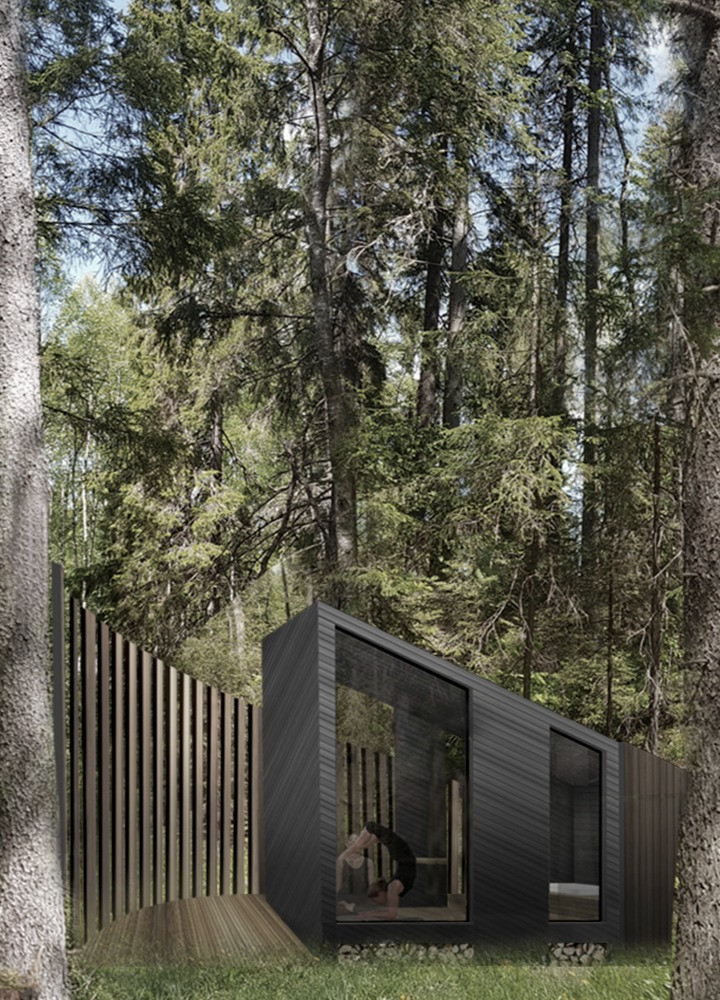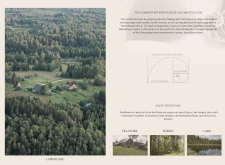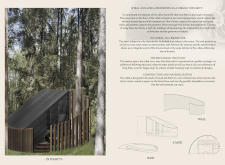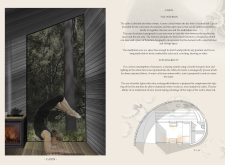5 key facts about this project
The function of this retreat is multi-faceted, serving primarily as a space for meditation, relaxation, and reconnection with nature. The architectural design carefully considers how occupants will interact with both the interior and exterior environments, thus fostering a sense of belonging within the natural world. The intentional layout includes areas dedicated to meditation, rest, and practical utility, each element contributing to the overall holistic experience the space provides.
One of the most notable aspects of the project is its design approach, which incorporates geometric principles rooted in nature. The cabin’s form reflects an organic quality, utilizing shapes and lines that are reminiscent of the natural environment. This synthesis of structural geometry and landscape results in an aesthetic that feels both modern and timeless. The use of a central, spiral form not only enhances visual appeal but also suggests a protective embrace, making the cabin feel secure and inviting.
A emphasis on materiality characterizes the architectural integrity of the cabin. The project primarily uses sustainably sourced wood, promoting environmental stewardship while enhancing the warmth and comfort of the interior spaces. Large windows constructed from glass are strategically placed to maximize natural light and provide expansive views of the verdant surroundings, effectively blurring the line between inside and outside. The incorporation of stone as a foundational element serves both functional and aesthetic purposes, grounding the structure and connecting it to the earth.
Another key detail within the design is the careful organization of interior spaces. The cabin contains a dedicated meditation area that fosters a conducive environment for mindfulness practices, designed with flexibility to accommodate various activities. Adjacent to this, the resting area emphasizes comfort through ergonomic furnishings, ensuring users can unwind and engage fully with their environment. Utility spaces are seamlessly incorporated, allowing for practical storage while maintaining aesthetic cohesiveness.
Sustainability is a cornerstone of the architecture in this project. The cabin features a rainwater harvesting system that showcases an understanding of natural resource management, promoting self-sufficiency and reducing dependency on external water supplies. Furthermore, the energy efficiency of the design is addressed through a combination of heating options, including the use of a hearth and solar energy sources, reflecting a modern approach to energy conservation without sacrificing comfort. The landscape surrounding the cabin is also taken into account, with proposals for the planting of native vegetation that enhances biodiversity and promotes a natural balance within the ecosystem.
The design embraces principles from Feng Shui, ensuring that the spatial arrangement encourages a positive flow of energy throughout the cabin. This thoughtful planning contributes to a calming atmosphere, where users can experience ease and clarity—a vital aspect of the retreat’s purpose.
Overall, this architectural project is a meaningful exploration of how design can facilitate a deeper connection with nature and self. It balances modern design aesthetics with traditional principles, creating a retreat that is both functional and reflective of its environment. The exploration of architectural plans, sections, and detailed designs may provide readers with further understanding of the architectural ideas showcased in this project. Those interested in delving deeper into this cabin retreat are encouraged to review the project presentation, where additional insights into its innovative design can be discovered.


























